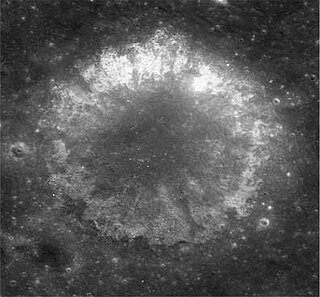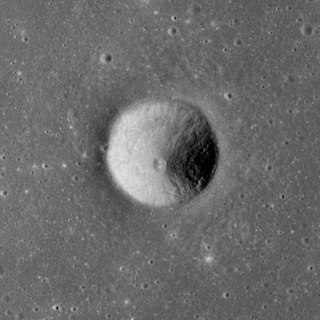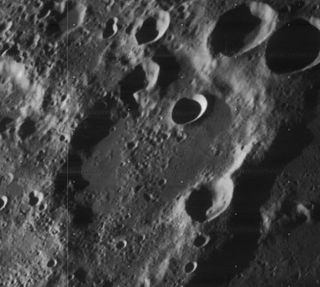
Aryabhata, named after Indian astronomer Aryabhata, is the remnant of a lunar impact crater located in the eastern Mare Tranquillitatis. The crater has been almost submerged by lava-flow, and now only an arc-shaped ridge formed from the eastern half of the rim remains above the lunar mare. This crater was previously identified as Maskelyne E before being named by the IAU in 1979. Maskelyne itself is to the southwest.

Sampson is a relatively tiny lunar impact crater located near the central part of the Mare Imbrium. It was named after British astronomer Ralph Allan Sampson. To the northeast is the crater Landsteiner and to the southeast lies Timocharis. East of this crater is the Dorsum Grabau, a wrinkle ridge in the mare.

Bobillier is a tiny, cup-shaped lunar impact crater in the southwest part of Mare Serenitatis. It was named after French geometer Étienne Bobillier in 1976. It lies to the north-northwest of the crater Bessel. To the south and west is a wrinkle ridge designated Dorsum Buckland. Bobillier was previously identified as Bessel E.

Very is a small lunar impact crater located in the eastern part of Mare Serenitatis, to the west-southwest of Le Monnier. It lies upon a wrinkle ridge that runs to the north and south named Dorsa Smirnov. It was named after American astronomer Frank W. Very. The crater was previously known as Le Monnier B, a satellite crater of Le Monnier, before being renamed by the IAU in 1973.

Aratus is a small lunar impact crater located on the highland to the south and east of the rugged Montes Apenninus range. It is a circular, cup-shaped crater with a relatively high albedo. It was named after Greek astronomer Aratus of Soli. To the east is the Mare Serenitatis, and to the southwest is the somewhat larger crater Conon. North-northeast of Aratus is the landing site of the Apollo 15 mission, just beyond Mons Hadley Delta.

Crile is a tiny lunar impact crater. It is roughly circular and cup-shaped, with interior walls that slope down to the midpoint. The crater lies in the Palus Somni, between the Mare Crisium to the east and Mare Tranquillitatis to the west.

Atwood is a small earth moon impact crater that is located on the Mare Fecunditatis, to the northwest of the prominent crater Langrenus. It forms a triple-crater formation with Naonobu attached to the north rim and Bilharz near the west rim.

Sarabhai is a small, circular, bowl-shaped crater on the Mare Serenitatis, in the northeast quadrant of the Moon. The formation is relatively isolated, being located to the northeast of the crater Bessel. It lies along a wrinkle ridge designated the Dorsum Azara.

King is a prominent lunar impact crater that is located on the far side of the Moon, and can not be viewed directly from Earth. The crater was named after Arthur Scott King and Edward Skinner King in 1970. Prior to that, this crater was known as Crater 211. It forms a pair with Ibn Firnas, which is only slightly larger and is attached to the northeast rim of King. To the northwest is the crater Lobachevskiy, and Guyot is located an equal distance to the north-northwest.

Gilbert is a large lunar impact crater that lies near the eastern limb of the Moon. Due to its location this feature appears foreshortened when viewed from the Earth, limiting the amount of detail that can be observed. The crater lies to the northwest of the similar-sized walled plain Kästner, to the west of the Mare Smythii.

Feuillée is a small lunar impact crater in the eastern part of the Mare Imbrium. It was named after French natural scientist Louis Feuillée. It lies less than a half crater diameter to the northwest of Beer, and the two formations form a nearly matched pair. To the west is the small but prominent crater Timocharis.

Daubrée is a lunar impact crater that is located to the southwest of the Mare Serenitatis, just to the west-southwest of the crater Menelaus in the Montes Haemus range. The small lunar mare Lacus Hiemalis lies along the southwest rim of Daubrée. The crater was named after French geologist Gabriel A. Daubrée. It was previously designated Menelaus S.

Hornsby is a tiny lunar impact crater in the western part of the Mare Serenitatis, a lunar mare in the northeast quadrant of the Moon's near side. It was named after British astronomer Thomas Hornsby. It is a solitary formation that is located at least 100 kilometers from any significant craters, although the curiously shaped depression Aratus CA lies about 50 km to the west-northwest. To the north-northwest is Linné, a feature notable for its skirt of high-albedo material. To the west of Hornsby is the wrinkle ridge Dorsum Von Cotta.

Kästner is a lunar impact crater that is located near the eastern limb of the Moon, to the southwest of the Mare Smythii. Just to the northwest of Kästner is the walled plain Gilbert. To the south is the prominent crater Ansgarius, and to the southwest lies La Pérouse.

Mons Hadley is a massif in the northern portion of the Montes Apenninus, a range in the northern hemisphere of the Moon. It has a height of 4.5 km (2.8 mi) 14,764 ft (4,500 m) above the adjacent plain and a maximum diameter of 25 km at the base.

Warner is a lunar impact crater that is located in the southern part of the Mare Smythii, near the eastern limb of the Moon. In this location the crater is viewed almost from the edge from Earth, and is sometimes hidden from sight due to libration. The crater lies just to the south-southeast of the very similar Runge. To the southwest is Widmannstätten, and to the south is the merged Kao–Helmert crater pair.

Dorsum Azara is a wrinkle ridge at 26.7°N 19.2°E in Mare Serenitatis on the Moon. It is 103 km long and was named after Spanish naturalist Félix de Azara in 1976.
Dorsum Gast is a wrinkle ridge at 24.0°N 9.0°E in Mare Serenitatis on the Moon. It is 65 km long and was named after American geochemist and geologist Paul Werner Gast in 1973.
Dorsum Von Cotta is a wrinkle ridge at 23.2°N 11.9°E in Mare Serenitatis on the Moon. It is 183 km long and trends south to north at approximately the lunar 12th parallel. It was named after German geologist Bernhard von Cotta in 1976.

Mons Argaeus is a mountainous massif on the Moon that extends for a length of 65 km towards the southeast. It is located at coordinates 19.33°N 29.01°E, wedging between Mare Serenitatis and Mare Tranquillitatis on their eastern border. The summit is approximately 2560 m above the plain of Mare Serenitatis to the west.



















